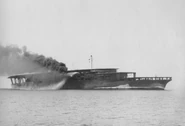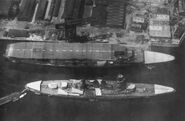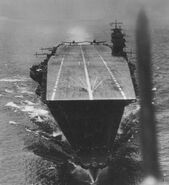Akagi (Japanese: 赤城, lit. Red Castle) was laid down on 6 December 1920, launched on 22 April 1925 and commissioned on 25 March 1927.
Description[]
She was an aircraft carrier of the Imperial Japanese Navy (IJN), named after Mount Akagi in present-day Gunma Prefecture. Though she was laid down as an Amagi-class battlecruiser, Akagi was converted to an aircraft carrier while still under construction to comply with the terms of the Washington Naval Treaty.[1] Based on a battlecruiser, Akagi was a unique looking aircraft carrier. At the time of her construction, there were not many air craft carriers in the navies around the world, hence there were no "standard design" at this early stage, which resulted in her unique configuration: triple-flight deck, unconventional port-side island, and six 8-in guns. As completed, the ship had two hangar decks, the hangars opened onto two superimposed flying off decks at the bow. In theory, this permitted aircraft to take off directly from the hangars, while landing on the main flight deck above. In practice, the multiple flight deck arrangement proved unsuccessful.
Following Japan's renunciation of the treaty in late 1934, the ship was rebuilt from 1935 to 1938, Akagi received a massive reconstruction at Sasebo Naval Arsenal with her original three flight decks consolidated into a single, enlarged flight deck, it also extended the hangars forward, removed the flying off decks, increased aircraft capacity and added an island superstructure on the unusual port side of the ship. The second Japanese aircraft carrier to enter service, and the first large or "fleet" carrier, Akagi figured prominently in the development of the IJN's revolutionary carrier striking force doctrine that grouped carriers together, concentrating their air power. This doctrine enabled Japan to attain its strategic goals during the first six months of the Pacific War.
Unfortunately, with her unique design came an unique weakness as well, and the weakness presented itself during the Battle of Midway. Aside from the fact that her anti-aircraft weaponry were of an older and slow-firing design, they were also positioned poorly. Her anti-aircraft batteries were positioned on the port and starboard sides of the ship, twenty or so feet below the flight deck, therefore guns on each side could only fire at targets on the same side of the ship. Additionally, port side guns are additionally blocked by the island, further reducing the effectiveness of the weapons. This was one of the many reasons why she was fatally attacked at Midway on 4 Jun 1942 at the hands of American dive bombers.
History[]
Akagi was the only ship of the Akagi-class aircraft carrier, the second IJN aircraft carrier and the first to be called as a 'fleet carrier' from the IJN. She was laid down on December 6, 1920 at Kure Naval Arsenal as an Amagi-class battlecruiser, her construction was halted due to the signing of the Washington Naval Treaty on February 6, 1922, which limit the total displacements of battleships and battlecruisers. But this authorized the IJN to convert Amagi-class battlecruisers into aircraft carriers. Amagi and Akagi were selected to be converted as aircraft carriers under the 1924 fleet construction program. 24.7 million was the original estimated budget to complete Akagi as a battlecruiser, they spended 8 million yen before her construction was halted, then an addition 90 million yen was approved by the Japanese National Diet which they will use to convert the battlecruisers into aircraft carriers.
On September 1, 1923, the Great Kanto Earthquake happened, the earthquake damaged Amagi's hull which is beyond repair, so they decided to scrapped her for materials. Akagi's construction as an aircraft carrier began on November 19, 1923, she was reclassified as an aircraft carrier on November 21, 1923. She was launched on April 22, 1925, she was transferred to Yokosuka Naval Yard upon competition. She was commissioned on March 25, 1927.
Her displacement is 36,500 tons, 41,300 tons when deep loaded. Her belt armor thickness is 6 inch while her deck armor thickness is 3.1 inch, she is equipped with an anti-torpedo bulge with 4 inch thickness. She achieved 32.5 knots on her trial on June 17, 1927. She's armed with six single 7.9 inch 50 cal. 3rd Year Type naval guns, six twin 4.7 inch 45 cal. 10th Year Type high-angle cannons, and fourteen twin 25mm Type 96 anti-aircraft auto-guns. She is equipped with 4 shafts and 4 Kampon geared turbines capable of generating 133,000 shaft horse power, she carries 3,900 tons of fuel and 2,100 of coal. She was installed with 3 superimposed flight decks which giver her the ability to launch her planes as quickly as possible. Her main flight deck is 190.2 meter, her middle flight deck is 15 meters while her lower flight deck is 55.02 meters. Her initial amount of aircraft she could carry is 60 aircraft with 150,000 gallons of aviation fuel (AvGas).
She was attached under the Combined Fleet (Rengo Kantai), her initial aircraft complement are 14 Mitsubishi Type 10 1MF3 fighters with 4 reserve, 24 Mitsubishi Type 13 B1M attack aircraft with 4 reserve, and 12 Mitsubishi Type 10 2MR recon aircraft. After several trials, she was put under reserve status. She was attached to the newly formed 1st CarDiv along with Houshou and participated on special fleet maneuvers. She was put on reserve again afterwards and undergone short refitting at Yokosuka Naval Yard. They replaced her arresting gear and improved and ventilation systems, they installed radio instrumentation system.
She resumed active service to the 1st CarDiv together with destroyers Minekaze, Yakaze, Sawakaze and Okikaze from DesDiv 2. She was reassigned and served as the flagship of the newly formed 2nd CarDiv with Minekaze and Okikaze. She was docked on Sasebo Naval Arsenal on October 24, 1935, and undergone to a massive modernization, her reconstruction take less work than Kaga but quite long because of the Great Depression. Her three flight decks were removed and replaced them with a single fight deck with an increased length of 249.17 meters, added her third elevator, replaced her arresting gears with Japanese-designed Type 1 system, they also increased her aircraft complement from 60 to 91, 66 operational and 25 on reserved, and an island superstructure was added on her portside. Her standard displacement increases to 37,100 tons which reduced her speed from 32.5 knots to 31.2 knots. Her modernization was completed on August 31, 1938.
After several trials, she resumed to active service and was assigned again to the 1st CarDiv escorted by destroyers Oite, Hayate, Asanagi and Yuunagi from DesDiv 29. She departed from Sasebo to Southern China afterwards, her air complement is now consisted of 12 Mitsubishi A5M Type 96 fighters with 4 reserved, 18 Aichi D1A2 dive-bombers with 5 reserved, and 36 Yokosuka B4Y attack aircraft with 16 reserved. She arrives off Hainan Island, China, and supported ground operations which includes several attacks on Guilin and Liuzhou, she provides air cover for the invasion force landing on Samah Bay along with Souryuu and Hiryuu from 2nd CarDiv and seaplane tender Chiyoda escorted by the DesRon 1.
After returning to Japan she was once again deployed to China, her aircraft complement is now consist of 18 A5Ms with 6 reserve, 27 Nakajima B5N torpedo bombers with 9 reserve, and 18 D1A2s with 6 reserve. She supported on further Japanese Operations within China. She also proceed through the Southern Pacific and supported IJA's operations. She was reclassified as a Special Purposed Ship on November 15, 1940 while she undergoes special inspection of her armaments, radio instrumentation and fire-control systems. On April 10, 1941, she was assigned and served as the flagship of the 1st CarDiv along with Kaga with destroyer Akebono and Ushio from DesDiv 7, the 1st CarDiv was assigned under the IJN 1st Air Fleet together with the 2nd CarDiv and 3rd CarDiv. They changed her aircraft complement again with 18 A5Ms with 3 reserve, 27 B5Ns with 3 reserve, 18 Aichi D3A dive-bombers with 3 reserve, she conducted several practices within home waters and undergone to four minor repairs and maintenance.
On November 22, 1941, she arrived at Etorofu Island (Iturup Island) and attended the secret assembly point for the planning of the attack on Pearl Harbor. They changed her aircraft complement again with 18 Mitsubishi A6M2 Type 0 fighters, 27 Nakajima B5N2 Type 97 torpedo-bombers, and 18 Aichi D3A1 Type 99 dive-bombers. On November 26, 1941, the 1st CarDiv was assign in 1st Air Fleet's Mobile Striking Force (Kido Butai) along with the 2nd CarDiv and 5th CarDiv escorted by 2 battleships from the BatDiv 3, 2 heavy cruisers from CruDiv 8, a light cruiser from DesRon 1, 4 destroyers from DesDiv 17 and 4 destroyers from DesDiv 18, with 8 tankers, 23 submarines and 4 midget submarines, Akagi was assigned as Vice Admiral Nagumo's flagship. The Kido Butai sailed off Hitokappu Bay and on their way to attack Pearl Harbor.
During the attack on Pearl Harbor, Akagi contributes 12 B5N2 torpedo bombers and 15 B5N2 each equipped with one 800-kg Type 99 model 5 bomb, that targeted battleships USS Maryland BB-46, USS California BB-44, USS West Virginia BB-48, USS Tennessee BB-43 and USS Oklahoma BB-37, and another 9 A6M2 fighters attacked Hickam Field and Marine Corps Air Station in Ewa Field, Oahu Island during the first wave. On the second wave she contributes 18 D3A1 dive bombers that targeted battleship USS Maryland BB-46, light cruiser USS Raleigh CL-7, oil tanker USS Neosho AO-23, destroyer USS Shaw DD-373 and Naval Air Station Ford Island, another 9 A6M2 fighters of her attacked Hickam Field Air Force Base again. She lost 1 A6M2 and 4 D3A1s during the attacks.
After Pearl Harbor, the 1st CarDiv together with the 5th CarDiv, they departed from Iwakuni to Truk with the BatDiv 3, DesRon 1 with DesDiv 18 and Akigumo. The departed from Truk with CruDiv 8. Akagi supported the invasion of Rabaul, she provided 20 B5N2s and 9 A6M2s during their initial attack, her planes bombed the Norwegian cargo vessel Herstein. On the next day, she launched 9 A6M2s and 18 D3A1s and attacked Allied positions nearby Kavien, New Ireland. Akagi launched another 6 A6M2s and 18 D3A1s for another airstrike on Rabaul before the ground forces landed and occupy Rabaul and Kavieng, the 1st and 5th CarDiv continued to provide air-cover throughout the invasion, after the invasion she departed for Truk afterwards.
She participated on the bombing of Port Darwin along together the 2nd CarDiv while screened by 2 heavy cruisers from CruDiv 8, 1 light cruiser from DesRon 1 with 4 destroyers from DesDiv 17, 2 destroyers from DesDiv 18, and 2 destroyers from DesDiv 27. She contributed 18 B5N2s during the first attack and 18 D3A1s and 9 A6M2s during the second attack. The raid sank 8 ships and damaged 9 ships with 15 Allied aircraft destroyed, Akagi didn't lost any planes during the raids. The Kido Butai also covered the troops during the invasion of Java. She was present in the raids within the Indian Ocean along with the 2nd and 5th CarDiv escorted by 4 battleships from BatDiv 3, 2 heavy cruisers from CruDiv 8, 1 light cruiser from DesRon 1 with 4 destroyers DesDiv 17, 4 destroyers from DesDiv 18, and 2 destroyers from DesDiv 4. She launched 17 B5N2s and 6 A6M2s and attacked British Air Base at Ceylon. They wrecked the base and destroyed 31 aircraft, her aircraft also sank destroyer HMS Tenedos and armed-merchant ship, HMS Hector. She also contributed for the sinking of British heavy cruisers HMS Dorsetshire and HMS Cornwall, she contributed 17 D3A1s during the attack. She also contributed of the sinking of British light aircraft carrier HMS Hermes and Australian destroyer HMAS Vampire, she launched 17 B5N2s and 3 A6M2s. The Kido Butai sank a corvette, 2 oil tankers, and a merchant ship afterwards. During the raid, 9 Bristol Blenheim MK-IV light bombers from the RAF 18th Squadron based on Colombo dropped bombs at Akagi, the bombs somehow missed her, three of the bombers were shot down by her Combat Air Patrol (CAP) and another one was shot down by a returning A6M2, she was the first carrier and the first time Kido Butai has been attacked since the start of the war. She returned to Japan to refit and replenish.
On May 27, 1942, she departed from Hashirajima for the Invasion of Midway along with the 2nd CarDiv escorted by battleship Haruna and Kirishima from BatDiv 3/2, heavy cruisers Tone and Chikuma from CruDiv 8, light cruiser Nagara from DesRon 10 with destroyers Nowaki, Arashi, Hagikaze and Maikaze from DesDiv 4, destroyers Yuugumo, Kazagumo, and Makigumo from DesDiv 10, and destroyers Urakaze, Tanikaze, Isokaze and Hamakaze from DesDiv 17. Akagi served as Vice Admiral Nagumo's flagship. Her aircraft complement was 24 A6M2s, 18 D3A1s, and 18 B5N2s.
On June 4, 1942, she arrived at Midway, she launched 18 D3A1s and 9 A6M2s during their initial attack, she lost one A6M, 3 A6Ms and 4 D3A1s were damaged 1 D3A was damaged beyond repair. The USN Task Force 16, which composed of 2 carriers, USS Enterprise CV-6 and USS Hornet CV-8 escorted by 5 heavy cruisers, 1 light cruisers and 11 destroyers ambushed the IJN Fleet after breaking a Japanese cipher about the operation Task Force 17, which composed of USS Yorktown CV-5 with 2 heavy cruisers and 6 destroyers, joined afterwards. She was attacked by aircraft which 6 Grumann TBF torpedo-bombers from Hornet and 4 land-based Martin B-26 medium bombers along with Hiryuu. Her CAP managed to shoot down all 4 B-26 with one A6M2 lost, she also avoided two torpedoes. One B-26 aircraft piloted by Lt. James Muri strafed Akagi's deck and attempted to crash on Akagi, the aircraft narrowly missed her bridge and plunge into the waters. Akagi's fighters intercepted 6 Douglas SBD dive-bombers from Marine Scout-Bombing Squadron 241 leaded by Maj. Lofton R. Henderson, Henderson was killed during the engagement, at the same time she was attacked by 12 USAAF Boeing B17 heavy-bombers dropped bombs at them, Akagi managed to avoid all the bombs. Her CAP fighters intercepted another incoming aircraft consist of 15 Douglas TBD torpedo-bombers from Hornet aiming at Souryuu, her CAP managed shot down all 15 planes. Then another 14 TBDs from Enterprise attempted to attack Kaga, Akagi launched additional 8 fighters and intercepted the incoming TBDs, they managed to shot down 10 out of 14 planes, she lost one fighter from the engagement.
At 10:26, Akagi and Kaga were attacked by 28 SBDs from USS Enterprise while aircraft from Yorktown attacked Souryuu. She was attacked by 3 of the 28 SBDs, one 1,000-lb bomb directly hit her amidships in the vicinity of her island and starts a fire, the second slices through her net-guards of the fantail and explodes under the port quarter, and one near-miss. Though the damage had been moderate, it seems that she on her preparation to launch another strike, with the result that the single bomb hit induces terrible explosions among the armed and fueled B5N2s within the hangar which resulted to multiple explosions that started a raging aviation gasoline fire from ruptured lines. Her damaged-control crew used one-shot CO2 fire-suppression system to control the fire within her but the burning aviation fuel were impossible to control, the flames began to advance deeper to her interior. Another near-miss damaged her rudder and was jammed while making evasive turns.
The fire eventually broke through her flight deck, Vice Admiral Nagumo transferred the flag to Nowaki then to Nagara, she stopped dead on water at 13:50, most of her crew already evacuated except Captain Aoki and her damage-control crew. She burned through the night but did not sink. Captain Aoki and her damage-control crew were evacuated afterwards after failing putting out the fire on her. At 04:50 of June 5, 1942, Admiral Yamamoto ordered to scuttle Akagi, destroyers Nowaki, Arashi, Hagikaze and Maikaze each fired one torpedo at her, two or three of the four torpedoes hit her starboard side, she sunk at 05:20. 1,070 of her crew including Captain Aoki were rescued by the destroyers while 115 engineers, 72 seamen, 68 mechanics, 7 aircrew men, 5 clerks, and 1 maintenance man were lost. She wasn't immediately removed from the IJN's Naval List, instead being listed as "unmanned", she was removed from the Naval List on September 25, 1942.
Akagi was sunk June 5, 1942, Midway Atoll, at position 30°30'N 178°40' W. The loss of Akagi and three other IJN carriers at Midway was a crucial strategic defeat for Japan and contributed significantly to the Allies' ultimate victory in the Pacific.[2]












